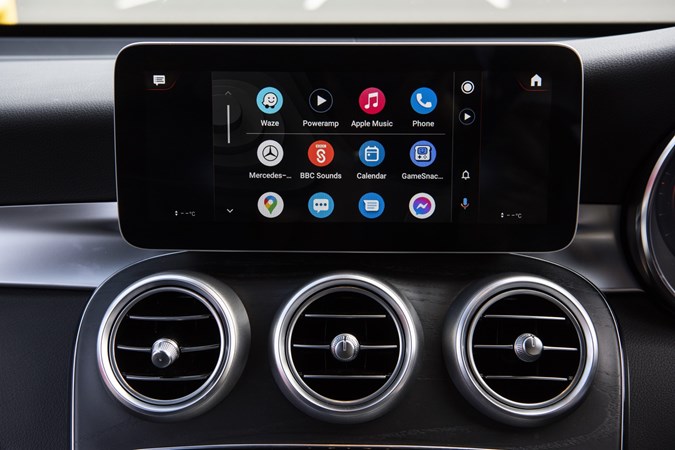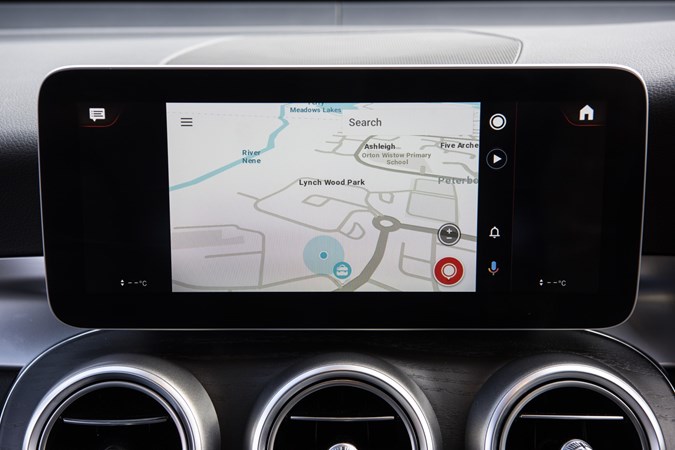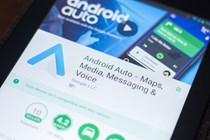Android Auto is an in-car phone mirroring system that allows Android users to project their phone display onto their infotainment screen to use on the go. When connected to an Android-based smartphone via Bluetooth, Wifi or cable, Auto launches and enables drivers to use a selection of services from their phone.
It’s Android’s answer to Apple CarPlay and similar to the platform-agnostic, yet less popular, Mirrorlink. By integrating these applications, car makers aim to minimise distracted driving and enhance comfort and in-cabin experience.
On this page, we’ll explore what Android Auto is and whether you really need it.
What exactly does Android Auto do?
Android Auto provides drivers with an alternative to using the manufacturer’s own infotainment system, from music play back to navigation. The latter is especially relevant, given the popularity of Google Maps, which is the default navigation for Android users.
Provided you have the Android Auto app downloaded to your handset, an Android phone running Android 8.0 operating system (OS) and a data plan, the car will offer the option to launch Android Auto.
Why do I need Android in my car?
Since 2003 it’s been illegal to use a handheld device behind the wheel of a vehicle in the UK. Despite the message “You cannot activate this feature while the vehicle is in motion” presented by some infotainment systerms, drivers every day are breaking the law to access functions and features on their phones.
By integrating Android Auto into the system, car makers hope to minimise driver distraction while adding a level of choice, comfort and convenience for owners of Android-based handsets.

Volvo has taken it one step further. Working directly with Android, the outgoing Volvo Sensus suite has been replaced entirely with an Android-based connectivity and infotainment system in all new cars, including the XC90 and XC40 Recharge.
By using an Android operating system, Volvo hopes to gain critical security smarts. After all, connecting to the internet wasn’t something the core software stack of a vehicle’s electronic system was built to do. Volvo can also use the pre-existing app store platform, Google Play Store—more sensible than creating its own, since removes a lot of friction for the consumer experience.
What does Android Auto enable you to do?
It’s important to note that although it’s a phone-mirroring feature, it doesn’t wholly ‘mirror’ what’s on your phone. Specifically the functions of “The Google Assistant”, Navigate (Google Maps or Waze), Communicate (Phone) and Entertain (Music and Audio) are accessible. Google’s weather app, your GCal calendar and other apps have been integrated to connect your life outside the car to your next journey.
The likes of Netflix, Amazon Prime and BBC iPlayer are not available. Though some would argue these apps would be useful for smaller passengers who don’t yet have their own handset, the rules are the rules.
How well does Android Auto work?
There’s been significant improvements of the Android Auto experience and now users can expect to connect easily, see chunky menu buttons (more accurately selected when the vehicle is in motion) and a good range of apps, all useful to the journey experience.
Google Maps and Waze are two of the most popular navigation tools—something Apple has struggled to keep pace with (so much so, it eventually had to relent and enable Google Maps to be added to the App Store. Ouch.)
Some drivers dismiss using sat-nav for every journey, especially on familiar routes. Yet, without a crystal ball, it’s impossible to know the road conditions on a given day at a given time. That’s where connected technologies come into their own.
Data has a bad reputation these days, and so it should. For a long time, companies like Google have been making money from consumers by selling their behaviourial data in exchange for ‘free’ use of their services. The truth is, nothing is free.

Android continues to collect behaviourial data, just as Apple does, and while the car makers aren’t really happy about it, it seems consumers’ demand for this functionality is greater than their desire to protect the information about their lives that the tech firms want access to.
The argument is much easier to understand when the sat-nav tells you that your normal route will take an extra 30 minutes due to an accident. In the past, the first you’d know of it is once you find yourself stuck in traffic.
Navigation apps can now re-route based on the information being fed into them in real-time. They disseminate this very quickly via Cloud technologies. We won’t go into that here, but it’s worth setting your navigation on every journey you take to get the best out of your technology.
Does my car have Android Auto?
Apple Carplay made it into vehicles first September 2014. Android Auto followed suit in the 2015 Hyundai Sonata, though integration in more vehicles lagged behind CarPlay for some time.
These days, the two competitors are achieving parity. Android Auto is available on a variety of new cars, ranging from the Volkswagen Golf and Vauxhall Astra to the Audi Q7 and Ford Kuga.
It’s worth noting that it’s not always standard, and that you’ll need to select it from the options list for some cars. If you’ve connected your cable, downloaded the app and you’re not seeing any prompts on your phone screen or the car’s centre display, it’s likely you don’t have Android Auto. Check with the dealership to be sure.
The Google Assistant can be initiated from the wake words ‘Hey Google’ or the car’s voice control activation button—you may need to hold it longer to get it to work. From there, you can command Google to navigate somewhere, write a message, call someone or play your preferred audio app. It’s super intuitive and accurate most of the time.
Though it claims to ‘Reserve Parking’, we haven’t yet tried these features out. It gives a flavour for how connected driving is going in the future though.
Looking for more jargon-busting motoring meanings? Head over to our Parkers Car Glossary page and take a look at our other definitions.
Just so you know, we may receive a commission or other compensation from the links on this website - read why you should trust us.








